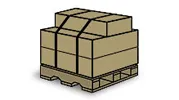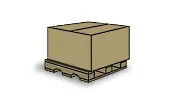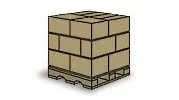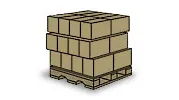LESS THAN TRUCKLOAD SHIPMENTS
Less Than Truckload (LTL) carriers typically transport shipments that are under 10,000 pounds. Shipments from several different customers are consolidated onto one trailer.
INTRODUCTION:
The rules and regulations of interstate shipping can sometimes seem overwhelming in the deregulated environment we now live in. There is much to understand to keep things running smoothly.
For instance, you will need to know how your product is defined by the trucking industry, how to complete important shipping documentation properly, and the right ways to package and secure your freight. You will also want to evaluate the variety of options that are available to you for getting your freight to its destination as quickly and reliably as possible.
This simple guide to shipping and receiving was designed with you in mind to help you and the people at your business master a few of the more common rules, regulations, and practices that go along with successful shipping and receiving which can be crucial for businesses to survive. We are sure that you will find the information and tips useful.
NATIONAL MOTOR FREIGHT CLASSIFICATION BOOK
The National Motor Freight Classification (NMFC) is a publication for motor carriers that contain rules, descriptions, and ratings of all commodities moving in commerce. The publication is used to classify freight for rating purposes.
In the world of interstate shipping, different types of products are defined according to their makeup. Each product definition is called a classification. The class of your freight plays a prominent role in calculating how much your carrier will charge you for transporting it. Freight classes are catalogued in the National Motor Freight Classification tariff.
Less than truckload carriers are compensated on a price per hundred pound basis. The NMFC assigns one of eighteen (18) different classifications for each item shipped; ranging from class 50 (slab steel) to class 500 (ping pong balls). The classes and weight breaks are illustrated below. Rates are structured so that as the weight of your shipment increases, the price per hundred pounds decreases. For very light shipments, most less than truckload carriers will state a minimum charge for the service.
Historically, the pricing for all classes of freight was expressed as a percentage of the rate for class 100. As an example, freight assigned a classification of 70 would pay 70% of the price (per hundred pounds) for a class 100 rate. While this proportional relationship no longer reflects exact percentages, it does allow a comparison of the relative expense of shipping one product versus another.
There are four characteristics of every article of freight that are analyzed to determine the NMFC classification. In order of importance they are;
Besides defining commodity classes, the NMFC also assigns item numbers to each type of commodity. The item number is related not only to the commodity itself, but to its; packaging, the material from which the commodity is made, and other considerations.
The NMFC is an excellent reference book for the transportation professional. It describes both shipper and carrier responsibilities. The NMFC includes:
BEFORE YOU SHIP YOUR PRODUCT
THE BILL OF LADING
Your bill of lading is an important document. It is a contract and it acts as a receipt for goods being transported. Take the time to fill out the bill of lading completely and correctly, since this will help ensure error free delivery to your customer. A correct bill of lading will also help ensure that you are invoiced accurately for the services provided.
Diversified Transportation Services can provide bills of lading for you. They are available in the forms section on our web site and can also be obtained from either your sales representative or our operations department.
As a courtesy, our operations department can either fax or email a completed bill of lading for your shipment. Please review all bills of lading carefully for accuracy and modify them as needed before signing them in preparation of tendering the freight to the carrier. Diversified Transportation Services makes no representation as to the accuracy of the information prepared on the bill of lading. You will be responsible to confirm the accuracy of the information on the bill of lading before you release your shipment to the trucking company.
Correct paperwork saves money. Even minor changes a carrier must make to shipping documents may incur charges. Avoid these by being 100% correct on your bill of lading.
How a Freight Rate is Calculated: How Much Will it Cost?
Freight rates are based on many factors, including:
The sample rate matrix below illustrates how a carrier’s rate table might look for rates between two zip codes. Weight breaks are indicated across the top. The classes are listed down the left side.
| Class | L5C | 5C | 1M | 2M | 5M | 10M | >20M |
|---|---|---|---|---|---|---|---|
| 50 | 34.30 | 28.32 | 24.25 | 23.04 | 17.58 | 15.74 | 10.47 |
| 55 | 36.94 | 30.50 | 26.12 | 24.82 | 18.93 | 17.41 | 11.58 |
| 60 | 39.59 | 32.69 | 27.99 | 26.60 | 20.29 | 19.08 | 12.69 |
| 65 | 41.94 | 34.64 | 29.66 | 28.18 | 21.49 | 20.27 | 13.48 |
| 70 | 44.64 | 36.86 | 31.56 | 29.99 | 22.88 | 21.94 | 14.59 |
| 77.5 | 48.10 | 39.72 | 34.01 | 32.32 | 24.65 | 23.85 | 15.86 |
| 85 | 51.90 | 42.86 | 36.70 | 34.87 | 26.60 | 26.24 | 17.45 |
| 92.5 | 55.89 | 46.15 | 39.52 | 37.56 | 28.64 | 28.38 | 18.87 |
| 100 | 60.27 | 49.77 | 42.61 | 40.50 | 30.89 | 30.77 | 20.46 |
Note in the sample matrix how the rates increase as the class goes up. Also note how the rates decrease as the weight break increases. There is a similar rate table for every origin/designation zip code combination serviced by a carrier. (C = 100 pounds, M = 1000 pounds)
Avoid billing corrections. Contact your representative to discuss the NMFC and your product’s classification.
Preparing Your Package
Proper packaging is a must. Don’t ship your goods without proper protection. Many claims and damages arise from improper packaging — and packaging errors may eliminate or reduce your carrier’s liability.
The pictures below should help you visualize the best way to package and secure your goods.
When possible, heavy, bulky items should be placed on pallets for improved handling. To maximize carton strength, stack cartons on the pallet vertically. You can secure cartons to a pallet with banding, shrink-wrap, stretch-wrap, or breakaway adhesive.
Cartons should be stacked squarely on the skid, with no overhang. Box flaps and corrugations should face up. Make the top surface as flat as possible.






Save money. If you ship many small shipments consolidate them. Try banding or stretch wrapping them onto a pallet. Your cost per hundred weight (CWT) will generally go down.
Eliminate extra charges. Be ready to accept the shipment when the carrier comes. Most carriers will add a “second delivery” charge if they must make another trip to your business.
Don’t delay shipments at the border with improper documentation. Shipments originating in Canada are subject to Canadian bill of lading contract terms and conditions. Contact your carrier’s representative for more details.
Save money. If it doesn’t need to be there the next day, don’t ship it overnight! In other words, whether you are the shipper or the consignee, communicate with your customer or supplier to make sure you both understand the shipping requirements.
Improve your company’s customer service. Visit us online for shipment status and other inquiries.
Whether you're a company looking to improve one facet of your supply chain, your entire supply chain, or simply looking for a transportation and logistics consultation, we can help.